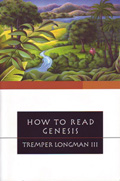
Tremper Longman III
Reviewed by: John Fesko
How to Read Genesis, by Tremper Longman III. Published by InterVarsity Press, 2005. Paperback, 192 pages, list price $13.00. Reviewed by OP pastor John Fesko.
Martin Luther (1483-1546) once wrote that Genesis 1 "is written in the simplest language; yet it contains matters of the utmost importance and very difficult to understand. It was for this reason, as St. Jerome asserts, that among the Hebrews it was forbidden for anyone under thirty to read the chapter or to expound it for others." For these reasons, Tremper Longman's book, How to Read Genesis, is a welcome contribution.
Longman identifies key factors in understanding how to read the first book of the Bible. First, he identifies its Christological goal, that "in Genesis . . . we get the first intimations of our Redeemer" (p. 9). Second, he sees the importance of reading Genesis in terms of the end, or eschatology: "It is of great significance that the last two chapters of Revelation (Rev 21-22) use language reminiscent of the Garden of Eden to describe the time of final reunion with God. The end brings us back to the beginning" (p. 15). And, third, he recognizes the importance of accounting for both the human and the divine authorship of Genesis: "While we ground our interpretation in what we propose is the meaning of the human author, we also believe that the divine intention can transcend that of the human author" (p. 18; cf. 1 Pet. 1:10-11). Longman uses these interpretive goals in his efforts to teach the reader how to read Genesis.
The author has divided his book into five parts, covering each aspect of the interpretive process: reading Genesis (1) with a strategy, (2) as literature, (3) in its own world, (4) as God's story, and (5) from a Christian perspective. In this fashion, Longman admirably covers Genesis, pointing out, for instance, the importance of recognizing the nuanced differences between the creation narratives and the patriarchal narratives. He also places each portion of Genesis within its original historical context. For example, he says that one of the intended purposes of Genesis was to counter the pagan worldviews of its day, not the scientific theories of Charles Darwin.
Longman rightly emphasizes that, when reading Genesis, it is important to look to its ultimate significance in terms of Christ. He devotes the last chapter to this important topic, but only gives four examples: the protoevangelium (3: 15), Abraham's seed (12:1-3), Melchizedek (14:17-20), and Joseph (37-50). One wishes that Longman had devoted more space to explaining the Christological significance of Genesis. Nevertheless, Longman's book is a must-read for the informed layman or minister who wants to move beyond a superficial understanding of the book of beginnings.
April 13, 2025
Suffering: God’s Purpose in Our Pain
April 06, 2025
Sunday Matters: 52 Devotionals to Prepare Your Heart for Church
March 30, 2025
On the Trail with a Missionary
March 23, 2025
Midnight Mercies: Walking with God Through Depression in Motherhood
March 16, 2025
March 09, 2025
Zwingli the Pastor: A Life in Conflict
March 02, 2025
© 2025 The Orthodox Presbyterian Church